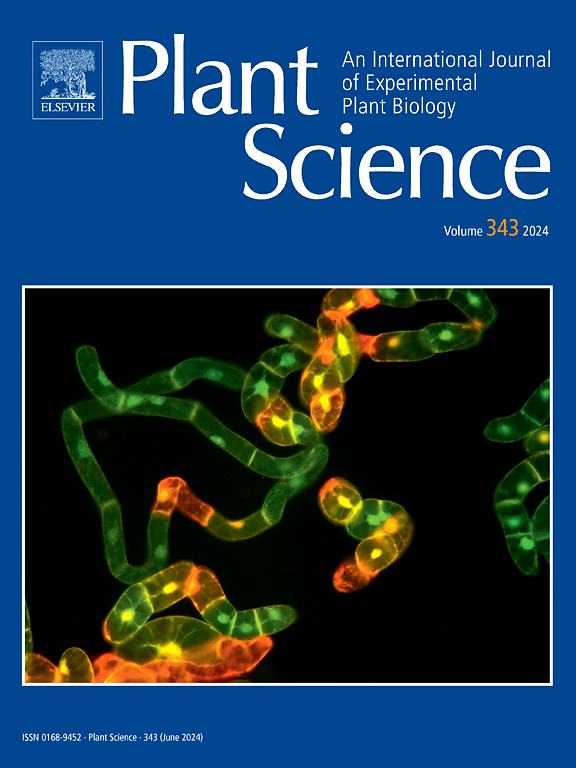Transcription factor CsNAC25 mediating dual roles in tea plant secondary cell wall formation and trichome development
IF 4.2
2区 生物学
Q2 BIOCHEMISTRY & MOLECULAR BIOLOGY
引用次数: 0
Abstract
Trichomes are a key feature of tea plants (Camellia sinensis L.) and essential for tea flavor compound formation, but their developmental mechanisms are still unclear. This study identified a transcription factor, CsNAC25, which positively regulates trichome formation in the ‘Qiancha 1’ tea plant cultivar. Phylogenetic analysis showed that CsNAC25 shares the highest homology with Arabidopsis XND1, and in situ hybridization revealed its specific expression in xylem cells and in trichomes of tea plant. Overexpression of CsNAC25 significantly inhibited xylem cell differentiation, reduced lignin and cellulose content, and led to a marked increase in trichome density. Conversely, using virus-induced gene silencing to silence CsNAC25 in tea plants resulted in reduced trichome density and elevated lignin content. Quantitative real-time PCR analysis showed that the expression of key phenylpropanoid pathway genes, such as NtPAL2, Nt4CL1, NtCAD1, and NtCCR1, was significantly reduced in the overexpression lines. Conversely, in the CsNAC25-silenced tea cuttings, the expression of CsPAL1, Cs4CL2, CsCAD1, and CsCCR1 was drastically increased. Moreover, the expression of CsMYB1, a positive regulator of trichome development, was significantly decreased in the CsNAC25-silenced lines. Further yeast one-hybrid and dual luciferase assays showed that CsNAC25 binds to the CsCCR1 promoter and represses its expression, suggesting that CsNAC25 regulates trichome development possibly by modulating CsCCR1 and impacting resource allocation within the phenylpropanoid metabolic network. In summary, our findings indicate that CsNAC25 in tea plants plays a dual role in regulating the secondary cell wall formation and trichome development.
转录因子CsNAC25介导茶树次生细胞壁形成和毛状体发育的双重作用
毛状体是茶树(Camellia sinensis L.)的一个重要特征,是茶味化合物形成的必需物质,但其发育机制尚不清楚。本研究鉴定了一个转录因子CsNAC25,该转录因子正调控“前茶1号”茶树品种的毛状体形成。系统发育分析表明,CsNAC25与拟南芥XND1具有最高的同源性,原位杂交显示其在茶树木质部细胞和毛状体中的特异性表达。CsNAC25过表达显著抑制木质部细胞分化,降低木质素和纤维素含量,导致毛状体密度显著增加。相反,在茶树中使用病毒诱导的基因沉默来沉默CsNAC25会导致毛状体密度降低和木质素含量升高。实时荧光定量PCR分析显示,过表达系中苯丙素通路关键基因NtPAL2、Nt4CL1、NtCAD1、NtCCR1的表达量显著降低。相反,在csnac25沉默的茶插枝中,CsPAL1、Cs4CL2、CsCAD1和CsCCR1的表达显著增加。此外,csnac25沉默系中毛状体发育的正调节因子CsMYB1的表达显著降低。进一步的酵母单杂交和双荧光素酶实验表明,CsNAC25与CsCCR1启动子结合并抑制其表达,表明CsNAC25可能通过调节CsCCR1和影响苯丙代谢网络中的资源分配来调节毛状体发育。综上所述,CsNAC25在茶树次生细胞壁形成和毛状体发育中具有双重调控作用。
本文章由计算机程序翻译,如有差异,请以英文原文为准。
求助全文
约1分钟内获得全文
求助全文
来源期刊

Plant Science
生物-生化与分子生物学
CiteScore
9.10
自引率
1.90%
发文量
322
审稿时长
33 days
期刊介绍:
Plant Science will publish in the minimum of time, research manuscripts as well as commissioned reviews and commentaries recommended by its referees in all areas of experimental plant biology with emphasis in the broad areas of genomics, proteomics, biochemistry (including enzymology), physiology, cell biology, development, genetics, functional plant breeding, systems biology and the interaction of plants with the environment.
Manuscripts for full consideration should be written concisely and essentially as a final report. The main criterion for publication is that the manuscript must contain original and significant insights that lead to a better understanding of fundamental plant biology. Papers centering on plant cell culture should be of interest to a wide audience and methods employed result in a substantial improvement over existing established techniques and approaches. Methods papers are welcome only when the technique(s) described is novel or provides a major advancement of established protocols.
 求助内容:
求助内容: 应助结果提醒方式:
应助结果提醒方式:


